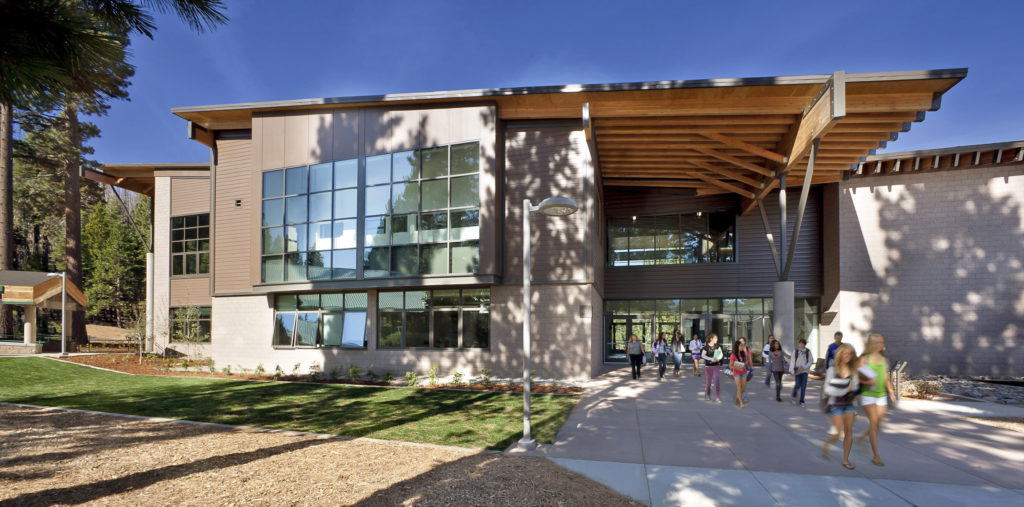Building efficiency and decarbonization is a movement that has the potential to dramatically curb climate change and make buildings healthy and productive spaces. K-12 schools, where staff and students spend at least 1,000 hours each year, are leading the way. Despite minimal funding, education is a leading sector of high-performance buildings and represented over thirty percent of projects on NBI’s Getting to Zero list in 2020, with 54% of those projects in K-12 schools. New Buildings Institute (NBI) offers a variety of tools and resources to support these efforts. While schools are historically underfunded, new local, state, and federal funding opportunities could provide the breakthrough districts need to take their energy efficiency to the next level – but not always in the way you might think.
States and cities are offering new programs to assist schools in the shift towards electrification and energy efficiency. For example, New York Governor Kathy Hochul announced $59 million for the Clean Green Schools initiative, which aims to advance clean and efficient energy, reduce emissions, and improve indoor environmental quality in more than 500 Pre-K-12 schools in underserved communities across the state. New York City Mayor Eric Adams then revealed “Leading the Charge” – a $4 billion plan to further support schools, advance electrification in schools, and improve learning environments, while fighting climate change and promoting green jobs.
In Maryland, the Maryland Energy Administration (MEA) established the Decarbonizing Public Schools Pilot Program to expand the capacity of local education agencies (LEAs) for managing energy data, reducing operating costs, and introducing energy performance criteria into capital improvement planning. Another example is in Colorado, where Governor Jared Polis has proposed a new six-year $150 million program for school bus electrification.
At the federal level, the U.S. Department of Energy (DOE) announced more than $80 million of funding as the first tranche of the Renew America’s Schools grant program in late October 2022. Created by President Biden’s Bipartisan Infrastructure Law, this program will provide a total of $500 million for energy and health improvements at public school facilities, especially those serving low-income and rural communities.
By prioritizing low-income and rural students and communities, the Renew America’s Schools program will address historic inequities in school facilities, while reducing energy costs and enhancing the learning environment.
The DOE also understands that many school districts lack funding and staff power to build institutional knowledge on energy efficiency to even inform their energy reduction plan. Thus, the DOE launched the Energy CLASS (Champions Leading the Advancement of Sustainable Schools) Prize to provide energy training for staff members at 25 high-need school districts to help them find, fund, and implement health and energy improvements.
While these federal and new state funding plans are exciting opportunities to make necessary infrastructure improvements in public schools, they are not enough to make continuous, long-term upgrades, and they will not be enough to reach all districts. In fact, 2021 State of Our Schools Report from the 21st Century School Fund, the International WELL Building Institute, and the National Council on School Facilities estimates the annual shortfall in school facility maintenance, operation, and needed upgrades is around $85 billion every year. Despite being the second largest sector of public infrastructure spending behind highways, K-12 school districts are still responsible for the majority of school construction capital funding.
We also know that over 50 percent of school districts in the U.S. require multiple building system updates or replacements to address health and safety concerns and 36,000 schools need updated HVAC systems. The need for more money and special programs to assist disadvantaged and low-income districts is clear and growing, but are new sources of funding enough to supplement local resources?
Bonds are the most often used source of funding to pay for school construction, major modernizations, and system replacement. Money already being used to fund school buildings should ensure it results in schools being efficient and healthy. By leveraging the advantages of energy efficiency and indoor air quality measures in school buildings, school districts can begin to gain the support of local stakeholders and unlock access to lasting funding through local bonds that result in efficient, healthy schools. Having clear messaging and a plan or roadmap in place makes it easier to communicate with voters about a district’s vision and the value of efficient, healthy, resilient, and carbon neutral schools.
To support districts in these efforts, New Buildings Institute (NBI) offers a variety of tools and resources. First, is a school key messaging guide that provides the rationale for efficient and healthy schools and explains how to communicate with various stakeholders. We also offer technically defensible and climate-specific project goals, a customizable sample resolution for school boards, and other templates that can be adapted for local use. All of these tools and resources are explained further in NBI’s Decarbonization Roadmap Guide for School Decision Makers.
Recently, NBI hosted a webinar discussing another way to gain stakeholder support – recognition awards. Last month, representatives from DOE, and Berkely Lab’s Efficient and Healthy Schools campaign joined us to kick off their second annual Recognition Program. School districts can receive national recognition for exemplary solutions and planning efforts by K-12 schools in the categories of Energy Efficiency Plus Health and Emissions Reduction and Resilience. Title I schoolwide program schools, rural schools, and schools in underserved communities are especially encouraged to apply.
At the webinar, Richard Perkins from Columbia Public schools (CPS) explained the value of winning recognition in the 2021 inaugural year of the campaign. He reported on the positive attention that the award created among stakeholders and voters in their community. Perkins also found that it offered an opportunity for the efforts of the district to be highlighted in national and local media, which is helpful when it comes time to pass a bond.
As part of the Efficient and Healthy Schools Campaign’s second year of the recognition program, school districts can receive recognition in the Planning Track or Implementation Track within the mentioned categories: Energy Efficiency Plus Health and Emissions Reduction and Resilience. In the Planning Track, participants will attend a webinar series (in one or both categories) co-hosted by NBI and will review tools and resources for creating a sustainability plan. Each webinar will be followed with half an hour of open time to dialogue with presenters, NBI staff, and each other to share best practices and experience. Participants in this track will then complete the recognition program by using what they learned to develop a plan that focuses on Energy Efficiency and Health improvements or Emissions Reduction and Resilience or combines them into one plan.
Links to the planning track webinars can be found below:
Energy Efficiency Plus Health
Emissions Reduction & Resilience
In the Implementation Track, schools will gain recognition for Energy Efficiency Plus Health or Emissions Reduction and Resilience measures that they have successfully completed. Participants will describe their approach and document success by providing data that shows facilities improvements and outcomes. Submissions will receive special mention of the work involved in Title I schools, rural schools, and schools in underserved communities. Download the application for the Implementation Track from the Efficient and Healthy Schools Campaign website.
Join the Efficient and Healthy Schools Campaign to connect with technical experts who can help improve energy performance and indoor air quality. They take a practical, solutions-based approach to HVAC and other technologies to reduce energy use and carbon emissions, so even if your schools don’t have budget, they can help with low- and no-cost ideas. We encourage school districts and anyone supporting them to join the campaign or sign up for one or both of the webinar series.
by Emma Riccardi, Project Analyst, New Buildings Institute

Bio
and Amy Cortese, Director of Programs, New Buildings Institute

Bio
Did you enjoy this content? Consider supporting NBI’s work with a donation today.

